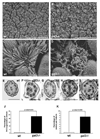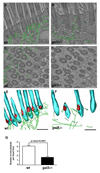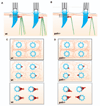Basal foot MTOC organizes pillar MTs required for coordination of beating cilia
- PMID: 25215410
- PMCID: PMC4993237
- DOI: 10.1038/ncomms5888
Basal foot MTOC organizes pillar MTs required for coordination of beating cilia
Abstract
Coordination of ciliary beating is essential to ensure mucus clearance in the airway tract. The orientation and synchronization of ciliary motion responds in part to the organization of the underlying cytoskeletal networks. Using electron tomography on mouse trachea, we show that basal bodies are collectively hooked at the cortex by a regular microtubule array composed of 4-5 microtubules. Removal of galectin-3, one of basal-body components, provokes misrecruitment of γ-tubulin, disorganization of this microtubule framework emanating from the basal-foot cap, together with loss of basal-body alignment and cilium orientation, defects in cilium organization and reduced fluid flow in the tracheal lumen. We conclude that galectin-3 plays a crucial role in the maintenance of the microtubule-organizing centre of the cilium and the 'pillar' microtubules, and that this network is instrumental for the coordinated orientation and stabilization of motile cilia.
Conflict of interest statement
the authors declare no conflict of interest.
Figures





References
-
- Mall MA. Role of cilia, mucus, and airway surface liquid in mucociliary dysfunction: lessons from mouse models. Journal of aerosol medicine and pulmonary drug delivery. 2008;21:13–24. - PubMed
Publication types
MeSH terms
Substances
Grants and funding
LinkOut - more resources
Full Text Sources
Other Literature Sources
Molecular Biology Databases
Miscellaneous

